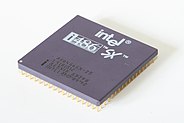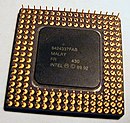
The Intel 386, originally released as 80386 and later renamed i386, is a 32-bit microprocessor introduced in 1985. The first versions had 275,000 transistors and were the CPU of many workstations and high-end personal computers of the time. As the original implementation of the 32-bit extension of the 80286 architecture, the i386 instruction set, programming model, and binary encodings are still the common denominator for all 32-bit x86 processors, which is termed the i386 architecture, x86, or IA-32, depending on context.

The Intel 486, officially named i486 and also known as 80486, is a microprocessor. It is a higher-performance follow-up to the Intel 386. The i486 was introduced in 1989. It represents the fourth generation of binary compatible CPUs following the 8086 of 1978, the Intel 80286 of 1982, and 1985's i386.

The Pentium is a fifth generation, 32-bit x86 microprocessor that was introduced by Intel on March 22, 1993, as the very first CPU in the Pentium brand. It was instruction set compatible with the 80486 but was a new and very different microarchitecture design from previous iterations. The P5 Pentium was the first superscalar x86 microarchitecture and the world's first superscalar microprocessor to be in mass production—meaning it generally executes at least 2 instructions per clock mainly because of a design-first dual integer pipeline design previously thought impossible to implement on a CISC microarchitecture. Additional features include a faster floating-point unit, wider data bus, separate code and data caches, and many other techniques and features to enhance performance and support security, encryption, and multiprocessing, for workstations and servers when compared to the next best previous industry standard processor implementation before it, the Intel 80486.

Cyrix Corporation was a microprocessor developer that was founded in 1988 in Richardson, Texas, as a specialist supplier of floating point units for 286 and 386 microprocessors. The company was founded by Tom Brightman and Jerry Rogers.

The Pentium Pro is a sixth-generation x86 microprocessor developed and manufactured by Intel and introduced on November 1, 1995. It introduced the P6 microarchitecture and was originally intended to replace the original Pentium in a full range of applications. While the Pentium and Pentium MMX had 3.1 and 4.5 million transistors, respectively, the Pentium Pro contained 5.5 million transistors. Later, it was reduced to a more narrow role as a server and high-end desktop processor and was used in supercomputers like ASCI Red, the first computer to reach the trillion floating point operations per second (teraFLOPS) performance mark. The Pentium Pro was capable of both dual- and quad-processor configurations. It only came in one form factor, the relatively large rectangular Socket 8. The Pentium Pro was succeeded by the Pentium II Xeon in 1998.

The Am5x86 processor is an x86-compatible CPU announced in November of 1995 by AMD for use in 486-class computer systems. It began shipping in December of 1995, with a base price of $93 per unit in bulk quantities. Before being released, it was in development under the codename "X5".

A coprocessor is a computer processor used to supplement the functions of the primary processor. Operations performed by the coprocessor may be floating-point arithmetic, graphics, signal processing, string processing, cryptography or I/O interfacing with peripheral devices. By offloading processor-intensive tasks from the main processor, coprocessors can accelerate system performance. Coprocessors allow a line of computers to be customized, so that customers who do not need the extra performance do not need to pay for it.

The Am386 CPU is a 100%-compatible clone of the Intel 80386 design released by AMD in March 1991. It sold millions of units, positioning AMD as a legitimate competitor to Intel, rather than being merely a second source for x86 CPUs.

Chips and Technologies, Inc. (C&T), was an early fabless semiconductor company founded in Milpitas, California, in December 1984 by Gordon A. Campbell and Dado Banatao.
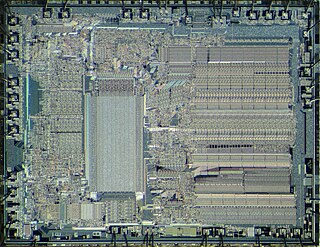
The Intel 8087, announced in 1980, was the first x87 floating-point coprocessor for the 8086 line of microprocessors.

The Cyrix Cx486SLC is a x86 microprocessor that was developed by Cyrix. It was one of Cyrix's first CPU offerings, released after years of selling math coprocessors that competed with Intel's units and offered better performance at a comparable or lower price. It was announced in March of 1992, and released 2 months later in May, with a price of $119. It was priced competitively against the Intel 486SX, causing Intel to lower the price of their chip from $286 to $119 in just days.

The Cyrix Cx486DLC is an x86 desktop microprocessor developed by Cyrix. It was Cyrix's second CPU offering, released years after selling math coprocessors that competed with Intel's units and offered better performance at a comparable or lower price. It was released in June of 1992, with a price of $119 for computer manufacturers.
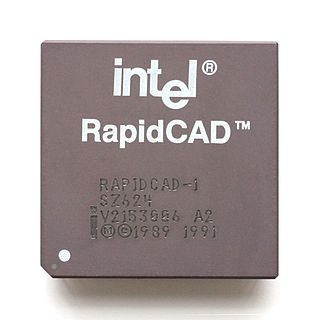
RapidCAD is a specially packaged Intel 486DX and a dummy floating point unit (FPU) designed as pin-compatible replacements for an Intel 80386 processor and 80387 FPU. Because the i486DX has a working on-chip FPU, a dummy FPU package is supplied to go in the Intel 387 FPU socket. The dummy FPU is used to provide the FERR signal, necessary for compatibility purposes.
x87 is a floating-point-related subset of the x86 architecture instruction set. It originated as an extension of the 8086 instruction set in the form of optional floating-point coprocessors that worked in tandem with corresponding x86 CPUs. These microchips had names ending in "87". This was also known as the NPX. Like other extensions to the basic instruction set, x87 instructions are not strictly needed to construct working programs, but provide hardware and microcode implementations of common numerical tasks, allowing these tasks to be performed much faster than corresponding machine code routines can. The x87 instruction set includes instructions for basic floating-point operations such as addition, subtraction and comparison, but also for more complex numerical operations, such as the computation of the tangent function and its inverse, for example.

The Intel 80387SX is the math coprocessor, also called an FPU, for the Intel 80386SX microprocessor. Introduced in 1987, it was used to perform floating-point arithmetic operations directly in hardware. The coprocessor was designed only to work with the 386SX, rather than the standard 386DX. This was because the original 80387 could not communicate with the altered 16 bit data bus of the 386SX, which was modified from the original 386DX's 32 bit data bus. The 387SX uses a 68-pin PLCC socket, just like some variants of the 80286 and the less common 80186 CPU, and was made in speeds ranging from 16 MHz to 33 MHz, matching the clock speed range of the Intel manufactured 386SX. Some chips like the IIT 3C87SX could get up to 40 MHz, matching the clock speeds of the fastest 386SX CPUs.
The 386SLC was an Intel-licensed version of the 386SX, developed and manufactured by IBM in 1991. It included power-management capabilities and an 8KB internal CPU cache, which enabled it to yield comparable performance to 386DX processors of the same clock speed, which were considerably more expensive. Known inside IBM as "Super Little Chip" for its initials, it was used in the IBM PS/2 35, 40 and 56 Series and in the IBM PS/ValuePoint 325T, but never gained much market share. This was mainly due to an agreement with Intel, in which IBM was not allowed to sell their CPUs if they were not part of a system or upgrade board. It was also marketed as an optional upgrade for 8086-equipped IBM PS/2 25 Series computers.
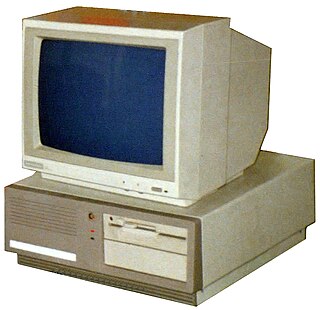
The Commodore PC compatible systems are a range of IBM PC compatible personal computers introduced in 1984 by home computer manufacturer Commodore Business Machines.
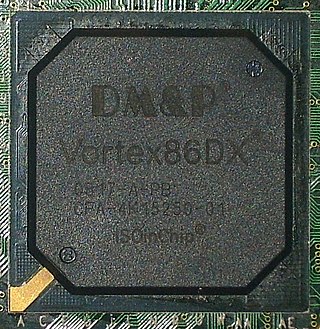
The Vortex86 is a computing system-on-a-chip (SoC) based on a core compatible with the x86 microprocessor family. It is produced by DM&P Electronics, but originated with Rise Technology.
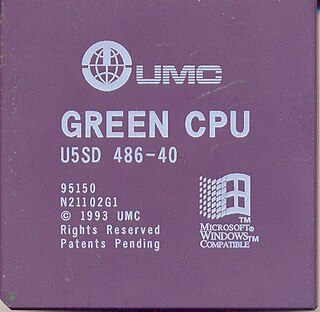
The UMC Green CPU was an x86-compatible microprocessor produced by UMC, a Taiwanese semiconductor company, in the early- to mid-1990s. It was offered as an alternative to the Intel 80486 with which it was pin compatible, enabling it to be installed in most 80486 motherboards. All models had power management features intended to reduce electricity consumption.

The Cyrix Cx486 was an x86 microprocessor designed by Cyrix. It primarily competed with the Intel 486 with which it was software compatible, would operate in the same motherboards provided proper support by the BIOS was available and generally showed comparable performance. The chip also competed with parts from AMD and UMC.
